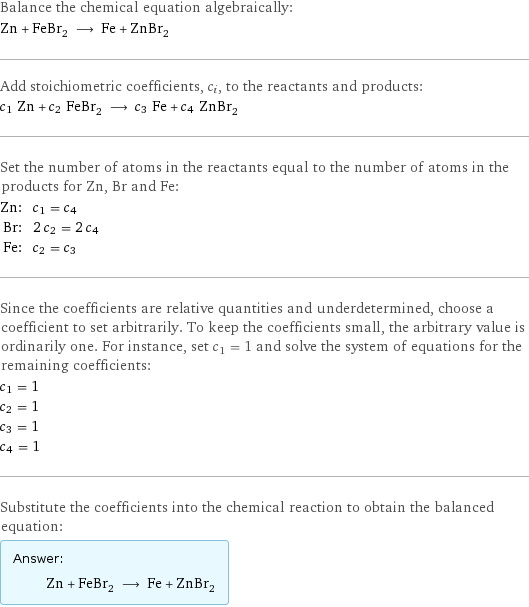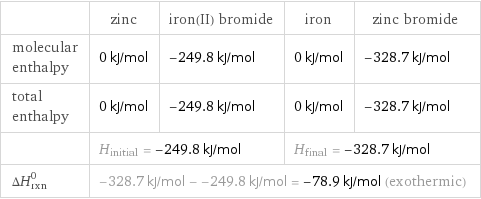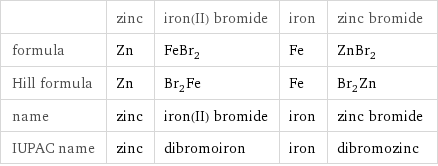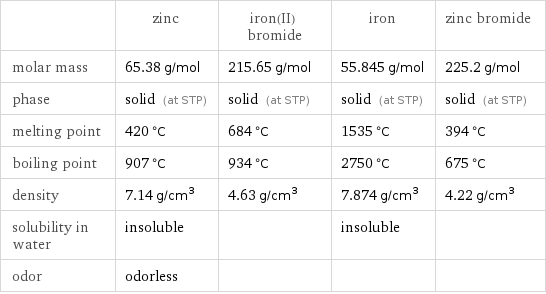Input interpretation

Zn zinc + FeBr_2 iron(II) bromide ⟶ Fe iron + ZnBr_2 zinc bromide
Balanced equation

Balance the chemical equation algebraically: Zn + FeBr_2 ⟶ Fe + ZnBr_2 Add stoichiometric coefficients, c_i, to the reactants and products: c_1 Zn + c_2 FeBr_2 ⟶ c_3 Fe + c_4 ZnBr_2 Set the number of atoms in the reactants equal to the number of atoms in the products for Zn, Br and Fe: Zn: | c_1 = c_4 Br: | 2 c_2 = 2 c_4 Fe: | c_2 = c_3 Since the coefficients are relative quantities and underdetermined, choose a coefficient to set arbitrarily. To keep the coefficients small, the arbitrary value is ordinarily one. For instance, set c_1 = 1 and solve the system of equations for the remaining coefficients: c_1 = 1 c_2 = 1 c_3 = 1 c_4 = 1 Substitute the coefficients into the chemical reaction to obtain the balanced equation: Answer: | | Zn + FeBr_2 ⟶ Fe + ZnBr_2
Structures

+ ⟶ +
Names

zinc + iron(II) bromide ⟶ iron + zinc bromide
Reaction thermodynamics
Enthalpy

| zinc | iron(II) bromide | iron | zinc bromide molecular enthalpy | 0 kJ/mol | -249.8 kJ/mol | 0 kJ/mol | -328.7 kJ/mol total enthalpy | 0 kJ/mol | -249.8 kJ/mol | 0 kJ/mol | -328.7 kJ/mol | H_initial = -249.8 kJ/mol | | H_final = -328.7 kJ/mol | ΔH_rxn^0 | -328.7 kJ/mol - -249.8 kJ/mol = -78.9 kJ/mol (exothermic) | | |
Equilibrium constant
![Construct the equilibrium constant, K, expression for: Zn + FeBr_2 ⟶ Fe + ZnBr_2 Plan: • Balance the chemical equation. • Determine the stoichiometric numbers. • Assemble the activity expression for each chemical species. • Use the activity expressions to build the equilibrium constant expression. Write the balanced chemical equation: Zn + FeBr_2 ⟶ Fe + ZnBr_2 Assign stoichiometric numbers, ν_i, using the stoichiometric coefficients, c_i, from the balanced chemical equation in the following manner: ν_i = -c_i for reactants and ν_i = c_i for products: chemical species | c_i | ν_i Zn | 1 | -1 FeBr_2 | 1 | -1 Fe | 1 | 1 ZnBr_2 | 1 | 1 Assemble the activity expressions accounting for the state of matter and ν_i: chemical species | c_i | ν_i | activity expression Zn | 1 | -1 | ([Zn])^(-1) FeBr_2 | 1 | -1 | ([FeBr2])^(-1) Fe | 1 | 1 | [Fe] ZnBr_2 | 1 | 1 | [ZnBr2] The equilibrium constant symbol in the concentration basis is: K_c Mulitply the activity expressions to arrive at the K_c expression: Answer: | | K_c = ([Zn])^(-1) ([FeBr2])^(-1) [Fe] [ZnBr2] = ([Fe] [ZnBr2])/([Zn] [FeBr2])](../image_source/6c4ed015f82a4767ff16fd522dcdb325.png)
Construct the equilibrium constant, K, expression for: Zn + FeBr_2 ⟶ Fe + ZnBr_2 Plan: • Balance the chemical equation. • Determine the stoichiometric numbers. • Assemble the activity expression for each chemical species. • Use the activity expressions to build the equilibrium constant expression. Write the balanced chemical equation: Zn + FeBr_2 ⟶ Fe + ZnBr_2 Assign stoichiometric numbers, ν_i, using the stoichiometric coefficients, c_i, from the balanced chemical equation in the following manner: ν_i = -c_i for reactants and ν_i = c_i for products: chemical species | c_i | ν_i Zn | 1 | -1 FeBr_2 | 1 | -1 Fe | 1 | 1 ZnBr_2 | 1 | 1 Assemble the activity expressions accounting for the state of matter and ν_i: chemical species | c_i | ν_i | activity expression Zn | 1 | -1 | ([Zn])^(-1) FeBr_2 | 1 | -1 | ([FeBr2])^(-1) Fe | 1 | 1 | [Fe] ZnBr_2 | 1 | 1 | [ZnBr2] The equilibrium constant symbol in the concentration basis is: K_c Mulitply the activity expressions to arrive at the K_c expression: Answer: | | K_c = ([Zn])^(-1) ([FeBr2])^(-1) [Fe] [ZnBr2] = ([Fe] [ZnBr2])/([Zn] [FeBr2])
Rate of reaction
![Construct the rate of reaction expression for: Zn + FeBr_2 ⟶ Fe + ZnBr_2 Plan: • Balance the chemical equation. • Determine the stoichiometric numbers. • Assemble the rate term for each chemical species. • Write the rate of reaction expression. Write the balanced chemical equation: Zn + FeBr_2 ⟶ Fe + ZnBr_2 Assign stoichiometric numbers, ν_i, using the stoichiometric coefficients, c_i, from the balanced chemical equation in the following manner: ν_i = -c_i for reactants and ν_i = c_i for products: chemical species | c_i | ν_i Zn | 1 | -1 FeBr_2 | 1 | -1 Fe | 1 | 1 ZnBr_2 | 1 | 1 The rate term for each chemical species, B_i, is 1/ν_i(Δ[B_i])/(Δt) where [B_i] is the amount concentration and t is time: chemical species | c_i | ν_i | rate term Zn | 1 | -1 | -(Δ[Zn])/(Δt) FeBr_2 | 1 | -1 | -(Δ[FeBr2])/(Δt) Fe | 1 | 1 | (Δ[Fe])/(Δt) ZnBr_2 | 1 | 1 | (Δ[ZnBr2])/(Δt) (for infinitesimal rate of change, replace Δ with d) Set the rate terms equal to each other to arrive at the rate expression: Answer: | | rate = -(Δ[Zn])/(Δt) = -(Δ[FeBr2])/(Δt) = (Δ[Fe])/(Δt) = (Δ[ZnBr2])/(Δt) (assuming constant volume and no accumulation of intermediates or side products)](../image_source/2f27a617956bb0695a0f7212e90d30e5.png)
Construct the rate of reaction expression for: Zn + FeBr_2 ⟶ Fe + ZnBr_2 Plan: • Balance the chemical equation. • Determine the stoichiometric numbers. • Assemble the rate term for each chemical species. • Write the rate of reaction expression. Write the balanced chemical equation: Zn + FeBr_2 ⟶ Fe + ZnBr_2 Assign stoichiometric numbers, ν_i, using the stoichiometric coefficients, c_i, from the balanced chemical equation in the following manner: ν_i = -c_i for reactants and ν_i = c_i for products: chemical species | c_i | ν_i Zn | 1 | -1 FeBr_2 | 1 | -1 Fe | 1 | 1 ZnBr_2 | 1 | 1 The rate term for each chemical species, B_i, is 1/ν_i(Δ[B_i])/(Δt) where [B_i] is the amount concentration and t is time: chemical species | c_i | ν_i | rate term Zn | 1 | -1 | -(Δ[Zn])/(Δt) FeBr_2 | 1 | -1 | -(Δ[FeBr2])/(Δt) Fe | 1 | 1 | (Δ[Fe])/(Δt) ZnBr_2 | 1 | 1 | (Δ[ZnBr2])/(Δt) (for infinitesimal rate of change, replace Δ with d) Set the rate terms equal to each other to arrive at the rate expression: Answer: | | rate = -(Δ[Zn])/(Δt) = -(Δ[FeBr2])/(Δt) = (Δ[Fe])/(Δt) = (Δ[ZnBr2])/(Δt) (assuming constant volume and no accumulation of intermediates or side products)
Chemical names and formulas

| zinc | iron(II) bromide | iron | zinc bromide formula | Zn | FeBr_2 | Fe | ZnBr_2 Hill formula | Zn | Br_2Fe | Fe | Br_2Zn name | zinc | iron(II) bromide | iron | zinc bromide IUPAC name | zinc | dibromoiron | iron | dibromozinc
Substance properties

| zinc | iron(II) bromide | iron | zinc bromide molar mass | 65.38 g/mol | 215.65 g/mol | 55.845 g/mol | 225.2 g/mol phase | solid (at STP) | solid (at STP) | solid (at STP) | solid (at STP) melting point | 420 °C | 684 °C | 1535 °C | 394 °C boiling point | 907 °C | 934 °C | 2750 °C | 675 °C density | 7.14 g/cm^3 | 4.63 g/cm^3 | 7.874 g/cm^3 | 4.22 g/cm^3 solubility in water | insoluble | | insoluble | odor | odorless | | |
Units
